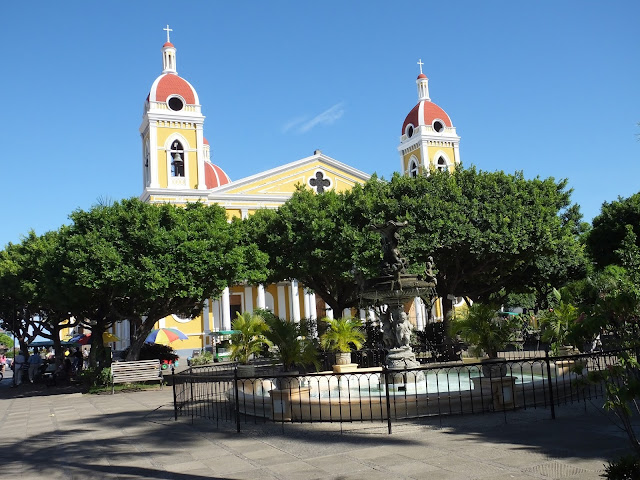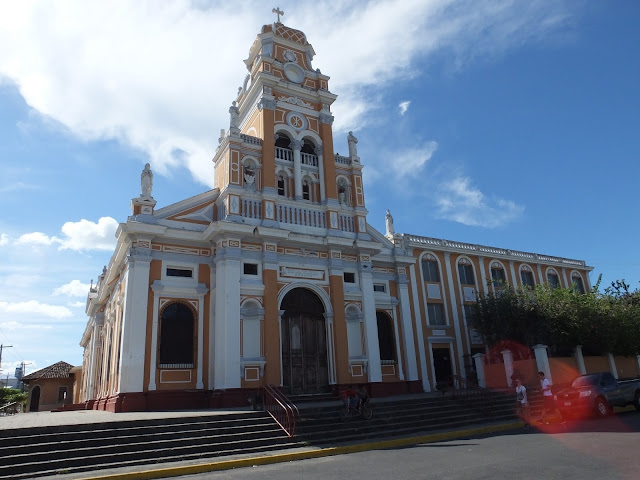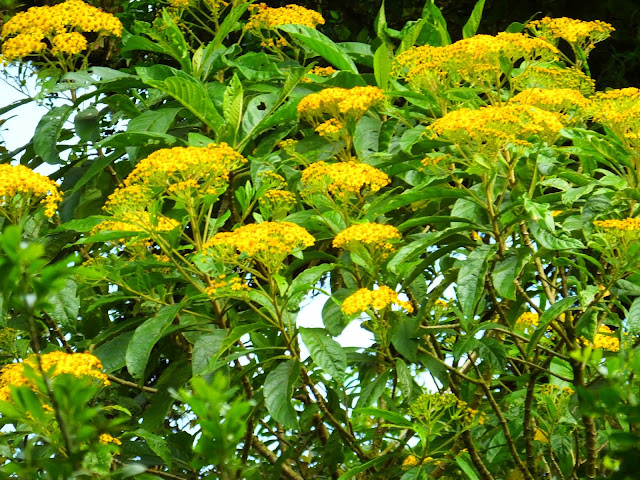Thursday afternoon I arranged a tour for Friday morning to
head up to the Mombacho Volcano. A driver and my knowledgeable guide for the
day Jose picked me up at 8:30 Friday morning. We drove out of town for several
kilometers to the park entrance where our driver would wait for us to return
from the top of the volcano. Then we had to wait for the giant truck that would
take us up the mountain. The truck looked like it was for African safaris with
a short walled bed with seats, a canvas cover to block the sun, but mostly open
on the sides and back.
We climbed into the truck up a small ladder with the few
other folks who were heading up the hill to explore Mombacho at that time. The
truck slowly wound up the very narrow, very steep, and very winding road. The
driver was nice enough to stop and pick up some young people who were walking
up the hill and drop them off near their homes. The road wound through coffee
plantations dappled with shade (a must for decent coffee production) and
jungles of thick trees covered with moss, orchids, and bromeliads. We made a
short stop at the coffee plantation Café Los Flores for a quick look around and
then loaded back up and continued the slow crawl up to the guide station near
the top of the volcano. Volcan Mombacho is considered dormant and has four
craters that can be hiked around. We were only going to hike around one of the
four.
We headed down the path and were quickly rewarded with a
viewpoint that looked down into a gigantic jungle-filled crater with a view of
Lake Cocibolca and Las Isletas in the background. The pictures really don’t do
it justice. Then we started down the trail though the jungles that surrounded
the crater. I say jungles because in the course of the hour or so hike we took
we passed through four different kinds of tropical forests. Jose was a wealth
of information about the flora and fauna of the area. He pointed out a small
plant that looked like a coffee plant with red berries and all but was actually
quite poisonous and could kill you if consumed. He also pointed out a plant
called picaya that resembled bamboo except for the hollow stems weren’t
sectioned like bamboo. He said the indigenous people who lived in the area had
used the picaya as tubes from which to blow poison darts while hunting. They
also made spears from it to be used in hunting and fishing. Every now and again
he’d stop to check out bromeliad leaves that had been torn out of the plant and
tossed on the trail after being eaten by howler monkeys. We heard them, but
never did see any.
We hiked down a narrow trail between two vertical rock walls
that took us to a lovely view of the crater. Once upon a time the path led to a
spring fed pool that served as the source of clean water for the indigenous people
who lived there. However, that part of the trail had become unstable and, after
some near death experiences from some visitors, had been closed. Another side
trail led us out to some fumaroles where hot sulfuric steam, hot enough to
steam up my glasses, came up from densely vegetated vents in the ground. This
was near a spectacular viewpoint from which you could see much of the area
surrounding Mombacho. I could see the Masaya Volcano, Laguna de Apoyo, the city
of Granada, and Las Isletas that I had glimpsed from the rim of the crater.
As we headed up towards the end of the trail we went through
a forest where the trees only grew to four or five meters (around 20 feet)
tall, which was unusual for such a low elevation. Then we were lucky enough to
spot a sloth hanging from a low tree near the path (okay, Jose totally saw him
and pointed him out to me). He was quite a good sport and let me take several
pictures of him without moving. We followed the rest of the trail back up to
the guide station where we were just in time to catch one of the trucks heading
back down the hill. Our driver was waiting for us and took us back into Granada
where they dropped me off safely at my hostel.
 |
| Sloth! |
I’ve come to be fond of these guided tours. As a traveler
and tourist who is moving around a lot it’s quite difficult to meet the locals
in a real way, but taking a tour with a local guide offers an opportunity to
spend a few hours with a local and learn about their life, their country, and
the things that interest them. While I could have done most of the tours
without a guide, I feel it’s a richer experience to have someone there who
knows the area and is excited to share their knowledge with a curious visitor.
As I’ve mentioned, Nicaraguans tend to be more reserved so I cherish the
opportunities when I can feel like I made a connection, however brief, with a
Nicaraguan. And hopefully we both come away with a little more understanding of
each other and the different places we’ve come from.






























































